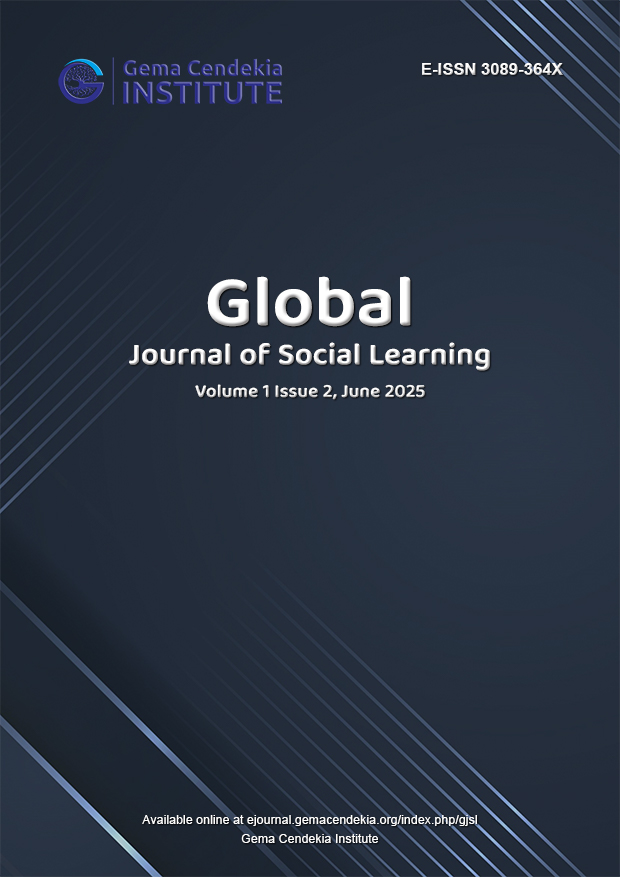Aesthetic Values in the Lyrics of the Song ภูเขา (Pūkheā) by Wing Sentot Irawan
DOI:
https://doi.org/10.71094/gjsl.v1i2.80Keywords:
Aesthetics, song lyrics, Wing Sentot Irawan, Pūkheā, musicAbstract
Abstract This research examines the aesthetic values embedded in the lyrics of the song ภูเขา (Pūkheā) by Wing Sentot Irawan. Through an aesthetic analysis approach, this paper aims to reveal the visual and auditory dimensions contained within the song. Furthermore, this study seeks to explore the philosophical meanings and reflections on life experiences as depicted by the composer. By investigating the interaction between text, context, and musical elements, this article demonstrates how the lyrics of this song serve not only as a musical composition but also as a medium of communication that possesses aesthetic significance, showcasing the interrelations of various components. The research was conducted using a descriptive qualitative research method with an ethnomusicological approach. The findings indicate that the lyrics of the song ภูเขา (Pūkheā) by Wing Sentot Irawan depict not only a physical journey but also an inner journey that embodies aesthetic values. The lyrics illustrate a harmonious relationship between language, nature, and civilization. By employing elements of nature, culture, and personal journeys as symbols, this song invites listeners to reflect on the meanings of life, civilization, and achievement.
References
Ardelia, Ailsa, & Agriyani, Dita Maulida. (2023). Analisis Semiotik Roland Barthes Video Musik Either Way - Ive. SABDA: Jurnal Sastra Dan Bahasa, 2(3), 38–43.
Busetto, Loraine, Wick, Wolfgang, & Gumbinger, Christoph. (2020). How to use and assess qualitative research methods. Neurological Research and Practice, 2(1). https://doi.org/10.1186/s42466-020-00059-z
Cahya, Asep Tian Dwi, Lestari, Riana Dwi, & Mustika, Ika. (2021). Analisis Makna Lagu “Lihat, Dengar, Rasakan” Dari Sheila on 7 Menggunakan Pendekatan Semiotika. Parole, 4(1), 67–76.
Chaplin, Adrienne Dengerink. (2019). Langer’s logic of signs and symbols: Its sources and application. Eidos: A Journal for Philosophy of Culture, 3(4), 44–54. https://doi.org/10.14394/eidos.jpc.2019.0041
De Fretes, Daniel, & Listiowati, Nensi. (2021). Pertunjukan Musik dalam Perspektif Ekomusikologi. Promusika, 8(2), 109–122. https://doi.org/10.24821/promusika.v8i2.4636
Deriu, Fabrizio. (2013). Performance Studies Floating Free of Theatre. Richard Schechner and the Rise of an Open Interdisciplinary Field. Revista Alicantina de Estudios Ingleses, (26), 13. https://doi.org/10.14198/raei.2013.26.02
Gerwen, Rob Van. (2012). Hearing musicians making music: A critique of roger scruton on acousmatic experience. Journal of Aesthetics and Art Criticism, 70(2), 223–230. https://doi.org/10.1111/j.1540-6245.2012.01514.x
Given, Lisa M. (Editor). (2008). The SAGE Encyclopedia of QUALITATIVE RESEARCH METHODS. In Lisa M. Given (Ed.), The Sage encyclopedia of qualitative research methods (1st&2nd ed.). California: SAGE Publications, Inc.
Hardjana, Suka. (1983). Estetika musik. In Jakarta: Depdikbud.
Hutcheon, Linda. (2013). A Theory of (2nd ed.). London and New York: Routledge.
Ishar, Rizky, & Irawan, Andi Muhammad. (2023). Semiotic Analysis of the Denotative and Connotative Meaning on the Beatles’ Songs Lyrics. E-Journal of English Language and Literature, 12(1), 154–167. Retrieved from http://ejournal.unp.ac.id/index.php/jell
Jr, David P. Pascua. (2022). Semiotic Analysis of Popular Love Songs. 1(1), 28–32.
Laksono, Arido. (2020). Representasi Budaya Lokal dalam Musik Kontemporer Indonesia. Jurnal Ilmiah Kajian Antropologi, 4(1), 50–54. Retrieved from https://www.kemdikbud.go.id/main/blog/2018/07/badan-bahasa-petakan-652-bahasa-daerah-di-
Mohajan, Haradan. (2018). Qualitative Research Methodology in Social Sciences and Related Subjects. Journal of Economic Development, Environtment and People, 7(1), 1–29.
N, Sahrul, (ISI Surakarta). (2015). Estetika Struktur Dan Estetika Tekstur Pertunjukan Teater Wayang Padang Karya Wisran Hadi. Institut Seni Indonesia Surakarta.
Ningsih, D P, Saputra, G. A. M., Suryadmaja, G., & Saearani, M. F. T. (2023). Perang Topat as a Model of Moderation between Hindus and Muslims in Lingsar, West Lombok Regency, Indonesia. Migration Letters, 20(5), 690–700.
Saleh, Firman, Aras, Nur Azizah M., & Wahyudi, Fitrawahyudi. (2023). Interpretasi Makna Lagu Bugis “Alosi Ripolo Dua”: Analisis Semiotika Roland Barthes. Jurnal Idiomatik: Jurnal Pendidikan Bahasa Dan Sastra Indonesia, 6(2), 185–195. https://doi.org/10.46918/idiomatik.v6i2.2115
Story, Dexter. (2022). A Brief Survey of Transcriptive Discourse Within Ethnomusicology In. 4(1), 1–23.
Suryadmaja, Galih. (n.d.). Mengoptimalkan Hasil Belajar Mahasiswa Melalui Pengembangan Media Rumah Cerita Pada Mata Kuliah Tata Teknik Pentas Prodi Pendidikan Sendratasik Unu Ntb. https://doi.org/Universitas Nahdlatul Ulama Nusa Tenggara Barat, Mataram, Indonesia
Suryadmaja, Galih. (2013). Ngringkes: Presentasai Atas Pesan Pendidikan. Jantra, Jurnal Sejarah Dan Budaya, 8(1), 29–38.
Suryadmaja, Galih. (2023). Mr. Yoi Sajikan Repertoar Pūkheā Di Selasa Warjack Taman Budaya NTB. Retrieved from Klikers website: https://www.klikers.id/read/special-klik/mr-yoi-sajikan-repertoar-pukhea-di-selasa-warjack-taman-budaya-ntb/
Suryadmaja, Galih. (2025a). Semiotic Analysis of John Fiske : The Meaning of the Song " Senja Kala Itu " by Gading Suryadmaja. 5(03), 325–335. https://doi.org/10.58471/jms.v5i03
Suryadmaja, Galih. (2025b). Sosiologi Seni: Memahami Interaksi Antara Seni dan Masyarakat. In Dewi Puspita Ningsih (Ed.), PT Rajawali Media Utama (I). Mataram: PT Rajawali Media Utama.
Suryadmaja, Galih, Fazli, Muhammad, & Saearani, Taib. (2025). Cantata Deo : Jurnal Musik dan Seni Studi Estetika Seni Pertunjukan di Era Global. 3(1), 71–86.
Yunus, H. Ahmad, Ks, Siti Dloyana, Mintosih, Sri, Soeloso, & Soimun. (1994). KESENIAN DALANG JEMBLUNG SEBAGAI SARANA PENYEBARAN NILAI BUDAYA. In Departemen Pendidikan Dan Kebudayaan Direktorat Jende Ral Ke Bu Dayaan Direktorat Sejarah Dan Nilai Tradisional Proyek Pengkajian Dan Pembinaan Nila I-Nilai Buday A Pusat. Jakarta.
Downloads
Published
Issue
Section
License
Copyright (c) 2025 Nurtikawati Nurtikawati (Author)

This work is licensed under a Creative Commons Attribution-ShareAlike 4.0 International License.










